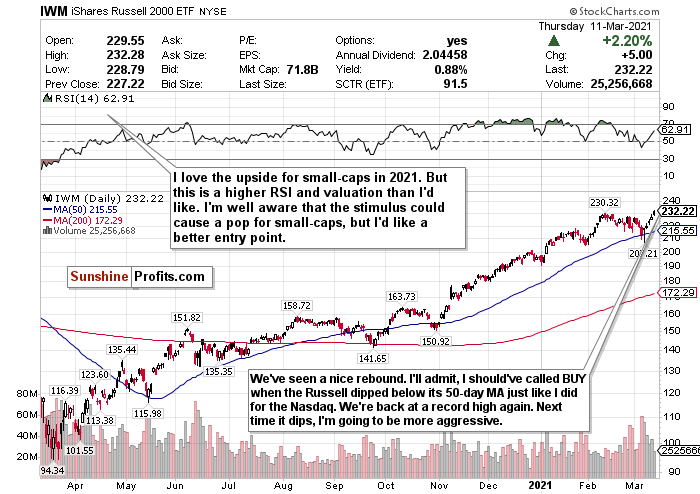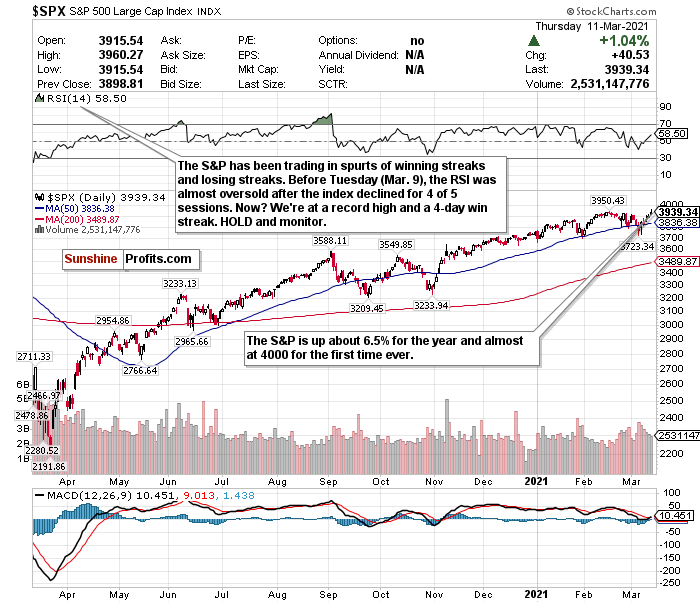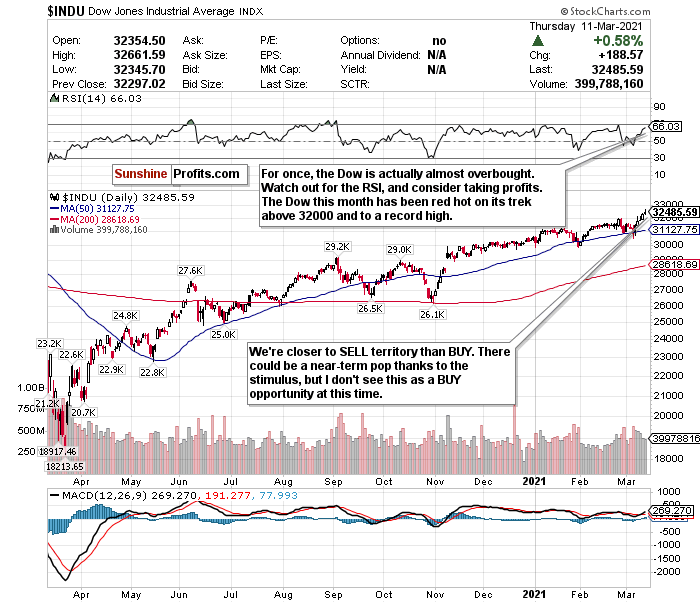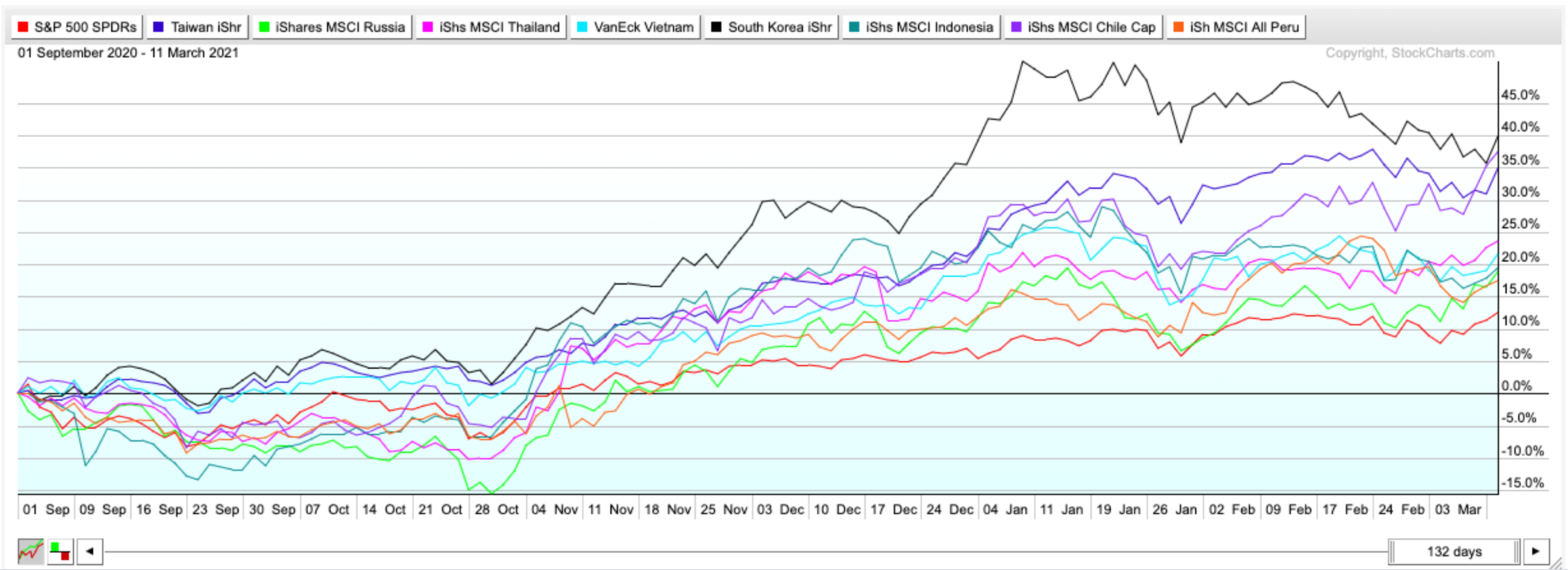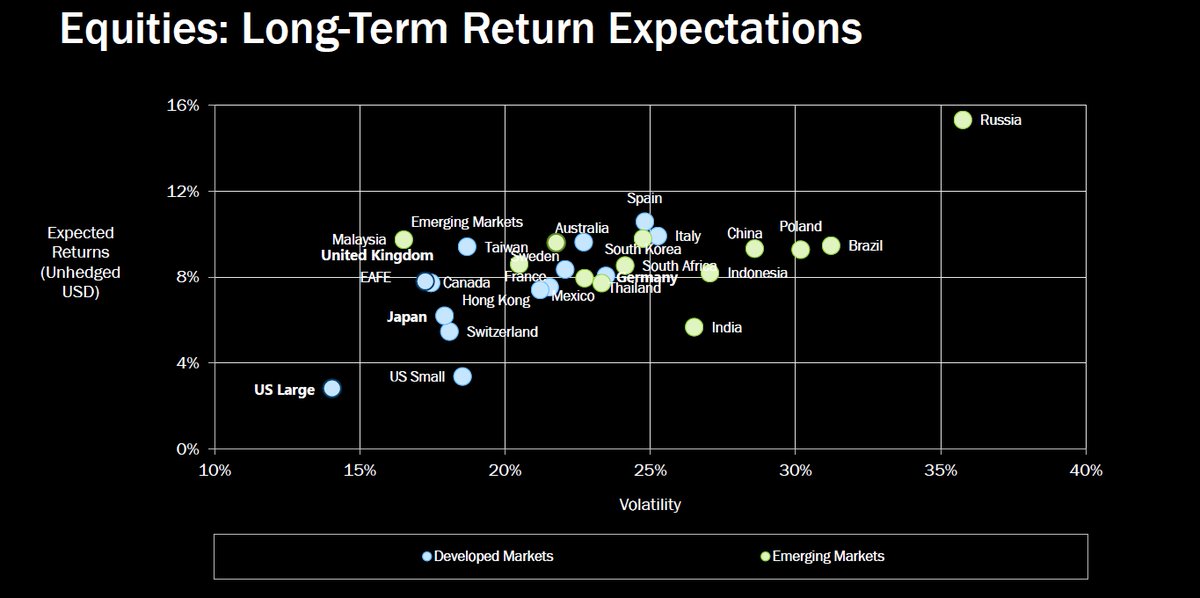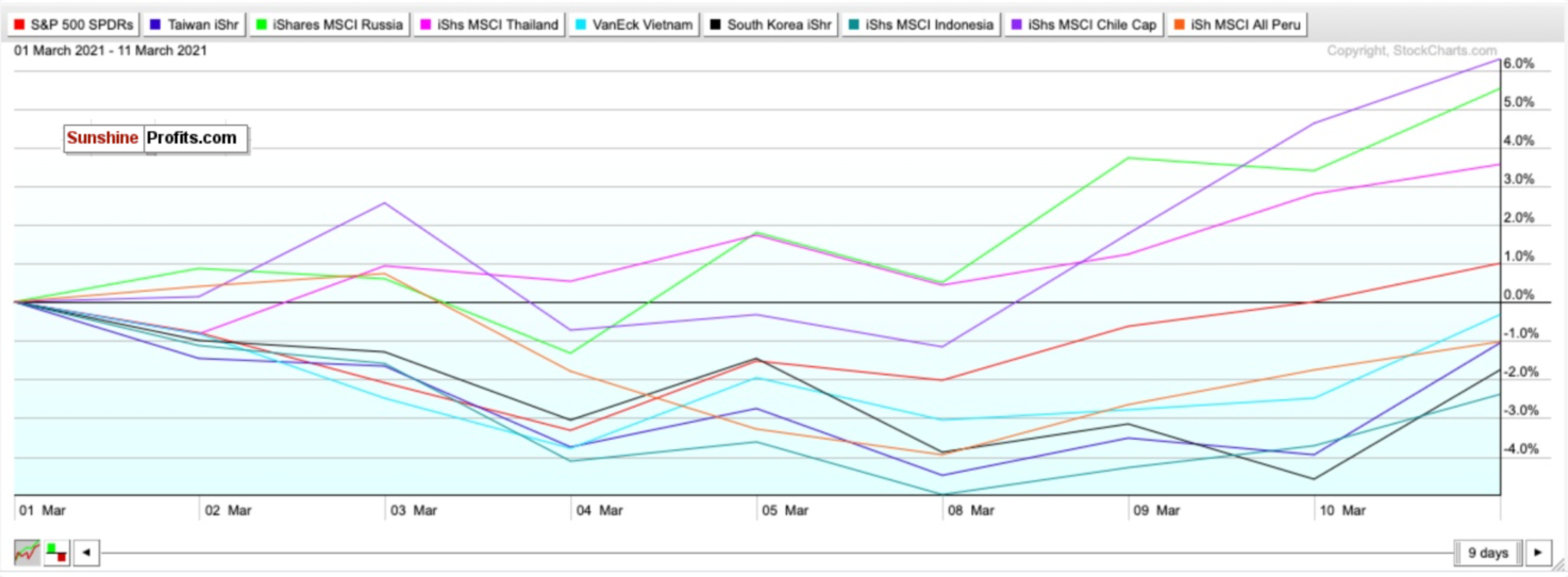Records were made to be broken. Thursday's (Mar. 11) session was just the embodiment of that. Every index closed in positive territory, and the Dow Jones, S&P 500, and Russell 2000 all closed at record highs.
Meanwhile, the Nasdaq led the way again with a 2.52% gain. After touching correction territory two times in the last week, the Nasdaq is up over 6.3% for the week. This is why you buy the dips, and why I said the second, the Nasdaq drops below 13000 support that you should buy.
Be bold, a little contrarian, block out the noise, and never try to time the market.
Sure, when you buy a dip during uncertain times, you run the risk of encountering more pain. However, in the long-term, stocks trend upwards.
For example, do you also know what happened precisely a year ago, on March 11, 2020? The headline on CNBC read like so: Dow plunges 10% amid coronavirus fears for its worst day since the 1987 market. See for yourself.
You know what else happened? The market didn't bottom for another 2 weeks and declined another 21%.However, if you bought the Dow-tracking DIA ETF on March 11 and held it this entire time, you'd have gained 40.51%. Imagine if you bought the dip as I recommended for tech.
I cautiously said to BUY the QQQ ETF, which tracks the Nasdaq, on February 24 but recommended doing it cautiously and selectively. I doubled down once it dropped below support at 13000 and tripled down once the Nasdaq hovered around 12600 on Monday (Mar. 8).
As I said before, the Nasdaq is up over 6.3% this week. If you followed my lead on this, you'd be pleased.
Inflation fears and the acceleration of bond yields are still a concern. But let's have a little perspective here. It appears as if things have stabilized for now. Bond yields are still at a historically low level, and the Fed Funds Rate remains 0%. Plus, jobless claims beat estimates again and came in at 712,000. This is nearly the lowest they've been in a whole year.
We will see how President Biden's newly signed $1.9 trillion stimulus package affects yields and inflation. But for now, with the Fed showing no signs of hiking rates shortly and inflation looking tamer than expected, we could see more firepower for stocks.
So is the downturn overblown and already finished?
Time will tell. I think that we could still see some volatile movements and consolidation to close the week out. That's just what happens with surges and swings like this. While I maintain that I do not foresee a crash like what we saw last March and feel that the wheels remain in motion for an excellent 2021, Mr. Market still has to figure itself out.
A broad-based correction of some sort is still very possible. I mean, the Nasdaq's already hit correction territory twice in the last week. Corrections are healthy and normal market behavior. Only twice in the previous 38 years have we had years WITHOUT a correction (1995 and 2017).
Most importantly, a correction right now would be an excellent buying opportunity. Once again- look at the Nasdaq since March 8.
It can be a very tricky time for investors right now. But never, ever, trade with emotion. There could be some more short-term pain, yes. But if you sat out last March when others bought, you are probably very disappointed in yourself.
You can never time the market.
My goal for these updates is to educate you, give you ideas, and help you manage money like I did when I was pressing the buy and sell buttons for $600+ million in assets. I left that career to pursue one to help people who needed help instead of the ultra-high net worth.
With that said, to sum it up:
There is optimism but signs of concern. The market has to figure itself out. A further downturn is possible, but I don't think that a decline above ~20%, leading to a bear market, will happen any time soon.
Hopefully, you find my insights enlightening. I welcome your thoughts and questions and wish you the best of luck.
Russell 2000- Big Upside, Missed Opportunity
Figure 1- iShares Russell 2000 ETF (IWM)
So remember when I said not to time the market?
I might have dropped the ball on that with the Russell 2000. I’ve wanted to buy the Russell 2000 badly, but never thought it was a big enough dip. I was waiting for it to at least approach a correction.
What made me hesitant about buying the Russell 2000 as tracked by iShares Russell 2000 ETF (IWM), was its rally since November and year-to-date. Even with its slowdown before this week, it was still way up and outperforming.
But now? Look at these gains.
Since the market’s close on October 30, the IWM has gained about 52.16% and more than doubled ETFs’ returns tracking the larger indices.
Not to mention, year-to-date, it’s already up over 20% and back at an all-time high.
With that $1.9 trillion stimulus package set to greatly benefit small businesses, the Russell could pop even more.
Unfortunately, I’m keeping this a HOLD. But I am monitoring the Russell 2000 closely.
I’ve learned this index doesn’t behave quite like the Nasdaq when it comes to the RSI. Aggressive stimulus, friendly policies, and a reopening world bode well for small-caps in 2021. I think this is something you have to consider for the Russell 2000 and maybe overpay for. The next time the index dips, I am going to be a little more aggressive.
The Streaky S&P Is in a Good Mood This Week
Figure 2- S&P 500 Large Cap Index $SPX
The S&P 500 is a complex index to call. It’s incredibly streaky and is between a rock and a hard place right now.
Before last Friday’s (Mar. 5) reversal upwards, the large-cap benchmark declined for 3 days in a row and 5 of 6 sessions.
Before Tuesday’s (Mar. 9) pop, it had declined in 4 of 5 sessions.
Now? We’re at a record high, close to 4000, and on a 4-day winning streak.
See where I’m going with this? To me, this is not behaving like a buyable index right now. I feel it’s best to sit and wait this out and monitor what happens.
Consider this too. Despite the gains of March 11, there was not a lot of breadth and depth. Only 60% of S&P stocks finished higher, while only 8 out of 11 S&P sectors finished in the green.
Unless I see some sort of buy or sell signal for the S&P 500, I think we’ll keep playing this streaky sideways game.
HOLD for now, but be prepared to either BUY or SELL depending on its moves. For an ETF that attempts to directly correlate with the performance of the S&P 500, the S&P 500 SPDR ETF (SPY) is a great option.
Is the Dow *Gulp* Overbought?
Figure 3- Dow Jones Industrial Average $INDU
Who would’ve thought the Dow Jones would approach overbought territory. All other indices have been trading with significant swings and volatility. In contrast, the Dow Jones has quietly managed to outperform and rise to record highs. It’s also at a record high and has been behaving more stable than the other indices.
Month-to-date, it has also been the best performing index and has risen about 3%.
However, I don’t feel that we’re buyable at all right now. Although the index could greatly benefit from the stimulus package due to all of the cyclicals in its index, the RSI is at 66 and ticking towards overbought.
So, where do we go from here?
Like the S&P, the Dow is between a rock and a hard place right now. But the Dow is not as close to buyable.
Many analysts believe the index could end the year at 35,000, and the wheels are in motion for a furious rally for the second part of the year. But you could do better for a buyable entry point.
From my end, I’d prefer to assess the situation.
My call on the Dow stays a HOLD, but this could change soon.
For an ETF that aims to correlate with the Dow’s performance, the SPDR Dow Jones ETF (DIA) is a reliable option.
Beware of Inflation
So is inflation really coming back, or is all this fear overblown?
BoA, in a March 10 note, described inflation as "well-contained." The bank also said that inflation fears would subside by the end of the year, and expects CPI inflation to be well shy of the Fed’s 2% target and hit 1.7% by the year's end.
Of course I respect BoA, but I think we're genuinely underestimating inflation. In fact, we are already experiencing it. Have you filled gas lately?
Bloomberg claims that food prices are also soaring faster than inflation and incomes. The January Consumer Price Index data also found that the cost of food eaten at home rose 3.7 percent from a year ago — more than double the 1.4 percent year-over-year increase in all goods included in the CPI.
The Economic Research Service for the U.S. Department of Agriculture also believes that the food cost from grocery stores will rise 1 to 2% this year.
Plus, Moody's Analytics chief economist Mark Zandi feels that investors have not fully grasped that inflation is "dead ahead" and are grossly underestimating its seriousness and effect on every sector in the market.
I have been calling out Jay Powell for weeks on this. I feel he is being cavalier in his inflation thoughts, and I did not buy what he was selling a few weeks ago. Good for him that inflation hasn't hit his magic 2% target yet. But he essentially admitted on March 4 what the worst kept secret in the book was- that we could see "temporary inflation."
"Temporary inflation"? We weren't born yesterday. Inflation isn't "temporary" unless you drastically hike rates. Once that happens, then all bets are off for stocks.
How long will the Fed do this song and dance? Who knows. They said they'd keep rates at 0% through 2023, but if inflation gets really bad, there's no way this can be sustainable.
Pent-up consumer demand is great. Retail sales crushing expectations reflect this. However, bond yields rising as fast as they have coupled with a Fed showing no signs of hiking interest rates is as strong a sign of inflation as you can get.
Five-year inflation expectations have also more than doubled from last year's low and are now at around their highest levels since 2013.
"The rich world has come to take low inflation for granted. Perhaps it shouldn't." -The Economist.
As hedges against inflation, consider BUYING the SPDR TIPS ETF (SPIP), the Invesco Optimum Yield Diversified Commodity Strategy No K-1 ETF (PDBC), and the iShares Cohen & Steers REIT ETF (ICF).
Mid-Term/Long-Term
Add Emerging Market Exposure- Period
Figure 4- SPY, EWT, ERUS, THD, VNM, EWY, EIDO, ECH, EPU comparison chart- Sep. 1, 2020-Present
Since September, the SPDR S&P 500 ETF (SPY) has gained around 12.53%.
But if you compare that yield to that of my top emerging market picks for 2021, it has underperformed.
Consider this too.
With inflation on the horizon, a surge in commodity prices combined with shifting demographics could send other emerging markets upwards long-term. Plus, with birth rates plummeting during the pandemic in developed markets, it could mean long-term upside for emerging markets.
PWC echoes this sentiment and believes that emerging markets (E7) could grow around twice as fast as advanced economies (G7) on average in the coming decades.
For 2021, the following are my BUYs for emerging markets and why:
iShares MSCI Taiwan ETF (EWT)- Developing country, with stable fundamentals, diverse and modern hi-tech economy, regional upside without China’s same geopolitical risks.
iShares MSCI Thailand ETF (THD)- Bloomberg’s top emerging market pick for 2021 thanks to abundant reserves and a high potential for portfolio inflows. Undervalued compared to other ETFs.
iShares MSCI Russia Capped ETF (ERUS)- Bloomberg’s second choice for the top emerging market in 2021 thanks to robust external accounts, a robust fiscal profile, and an undervalued currency. Red-hot commodity market, growing hi-tech and software market, increasing personal incomes. Russian equities may also have potential upside north of 35%.
Figure 5- Equities: Long-Term Return Expectations Developed Markets/Emerging Markets
VanEck Vectors Vietnam ETF Vietnam (VNM)-Turned itself into an economy with a stable credit rating, strong exports, and modest public debt relative to growth rates. PWC believes Vietnam could also be the fastest-growing economy globally. It could be a Top 20 economy by 2050.
iShares MSCI South Korea ETF (EWY)- South Korea has a booming economy, robust exports, and stable yet high growth potential. The ETF has been the top-performing emerging market ETF since March 23.
iShares MSCI Indonesia ETF (EIDO)- Largest economy in Southeast Asia with young demographics. The fourth most populous country in the world. It could be less risky than other emerging markets while simultaneously growing fast. It could also be a Top 5 economy by 2050.
iShares MSCI Chile ETF (ECH)- One of South America’s largest and most prosperous economies. An abundance of natural resources and minerals. World’s largest exporter of copper. Could boom thanks to electric vehicles and batteries because of lithium demand. It is the world’s largest lithium exporter and could have 25% of the world’s reserves.
iShares MSCI Peru ETF (EPU)- A smaller developing economy but has robust gold and copper reserves and rich mineral resources.
Let’s take a look at how these emerging markets have performed in March so far.
Figure 6- SPY, EWT, ERUS, THD, VNM, EWY, EIDO, ECH, EPU comparison chart- March month-to-date
Commodities are once again the big story. Copper has made a big comeback since March 4 and has rallied 4% since then. Lithium, a crucial battery metal, as tracked by the LIT ETF, has also gained over 8% since March 4. Oil is surging as well.
That’s why Chile and Russia are leading the way thus far this month.
Remember. Chile is one of Latin America’s most robust economies and the world’s largest copper and lithium exporter. It could, in fact, have 25% of the world’s lithium reserves.
Regarding Russia, Boris Schlossberg, managing director at BK Asset Management, told CNBC’s “Trading Nation” that the rise in oil is very beneficial for Russia’s growth.
“It’s pretty clear that oil has really found a very, very strong consolidation of the $60 level ... if you’re a big believer that oil stays, these levels go higher. It’s very positive for Russia, very positive for the Russian economy.”
Schlossberg also looked at Goldman’s call for commodities to return 15.5% over the year as strong for Russia.
“Goldman’s thesis that commodities are entering into a very strong bull market because of infrastructure needs all across the world only helps Russia.”
Outside of the aforementioned country-specific ETFs, you can also BUY the iShares MSCI Emerging Index Fund (EEM) for broad exposure to Emerging Markets.
Long-Term
I remain convinced that the economic recovery is going better than expected as the progress in administering the vaccines improves. But it’s a blessing and a curse if it goes “too well.”
Continue to pay attention to complacency, overvaluation, bond yields, and especially inflation.
Time will tell what happens with the market. There could be more short-term swings. But the economic climate is reopening, and things look a bit sunnier than they did at this time a year ago.
I think we could see some more swings as the market figures out bond yields and inflation. We may be at the beginning of the end of the pandemic, and despite some choppy waters, 2021 should be a big year for stocks.
Summary
I cannot stress this enough. Weeks like this one are why you buy the dips and why you can never try and time the market.
Do not get caught up in fear and most of all:
NEVER TRADE WITH EMOTIONS.
Consider this too. You can sit out and be scared and wait for the perfect buying opportunity all you want. But we are almost a year out from March 23rd, 2020- the day that the market finally bottomed. If you bought ANY of these index-tracking ETFs on March 23rd when it looked like the world was ending, here is how you would have fared: Russell 2000 (IWM) up 135.77%. Nasdaq (QQQ) up 87.51%. S&P 500 (SPY) up 78.76%. Dow Jones (DIA) up 77.50%.
Nobody knows “where” the actual bottom is for stocks. However, in the long-term, markets always move higher and focus on the future rather than the present.
For now, even though bond yields and inflation appear to have stabilized, I’m still a bit concerned. This $1.9 trillion rescue deal may be a short-term catalyst for stocks. But it’s only prolonging the inevitable. Inflation will eventually return with a vengeance. Bond yields will ultimately rise even more as the GDP heats up, and debt will continue to grow. But for now? Enjoy the ride. Just maybe avoid filling gas. It’s getting ugly out there.
To sum up my calls:
I have HOLD calls for:
- The Invesco QQQ ETF (QQQ),
- the iShares Russell 2000 ETF (IWM),
- the SPDR S&P ETF (SPY), and
- the SPDR Dow Jones ETF (DIA)
I also recommend selling or hedging the US Dollar and gaining exposure into emerging markets for the mid-term and long-term.
I have BUY calls on:
- The iShares MSCI Emerging Index Fund (EEM),
- the iShares MSCI Taiwan ETF (EWT),
- the iShares MSCI Thailand ETF (THD),
- the iShares MSCI Russia ETF (ERUS),
- the VanEck Vectors Vietnam ETF (VNM),
- the iShares MSCI South Korea ETF (EWY),
- the iShares MSCI Indonesia ETF (EIDO),
- the iShares MSCI Chile ETF (ECH),
- and the iShares MSCI Peru ETF (EPU)
Additionally, because inflation has already crept back; and I foresee it getting worse as early as mid to late 2021…
I have BUY calls on:
- The SPDR TIPS ETF (SPIP),
- the Invesco Optimum Yield Diversified Commodity Strategy No K-1 ETF (PDBC), and
- the iShares Cohen & Steers REIT ETF (ICF)
Thank you.
Matthew Levy, CFA
Stock Trading Strategist


